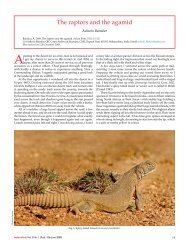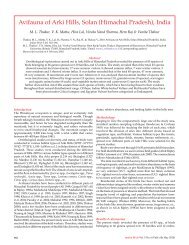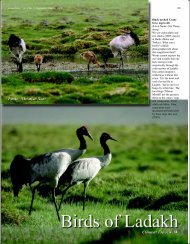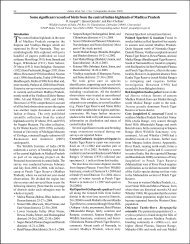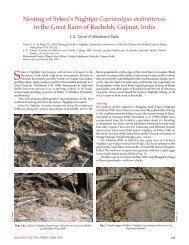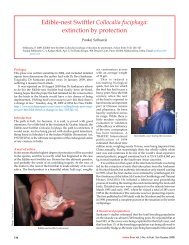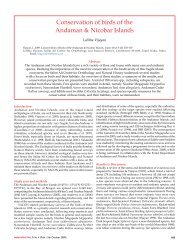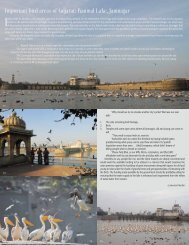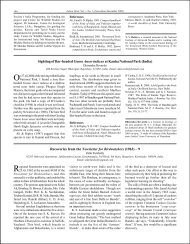Birding adventures in Kachchh, Gujarat - Indian Birds
Birding adventures in Kachchh, Gujarat - Indian Birds
Birding adventures in Kachchh, Gujarat - Indian Birds
Create successful ePaper yourself
Turn your PDF publications into a flip-book with our unique Google optimized e-Paper software.
102<br />
<strong>Indian</strong> <strong>Birds</strong> Vol. 6 Nos. 4&5 (Publ. 20 November 2010)<br />
Ashw<strong>in</strong> Pomal<br />
Fig. 5. Caspian Tern adults and young.<br />
The breed<strong>in</strong>g season of the Caspian Tern recorded on Khijadia<br />
bet is quite different from the Charakla saltpans (May–June)<br />
of Jamnagar district, <strong>Gujarat</strong> (Bhatia 2004). It is June-July <strong>in</strong> Pakistan<br />
(Roberts 1991–1992), and between May and June <strong>in</strong> Sri<br />
Lanka (Ali & Ripley 1983).<br />
Population size: On 18 September 2009, we counted<br />
64 nest depressions, and 150 adult Caspian Terns around the<br />
colony at Khijadiya bet. This is much less than the number of<br />
nests / pairs recorded breed<strong>in</strong>g on the same bet by Tiwari et al.<br />
(1997) <strong>in</strong> 1993 (200 nests), and 1994 (300 nests). At Charakla<br />
Saltpans, Bhatia (2004) recorded 452 nests <strong>in</strong> June 2003, and<br />
1,600 adult terns on the colony <strong>in</strong> July 2003.<br />
Acknowledgements<br />
Bhikha Bhagat had discovered this colony <strong>in</strong> 1993 and had shown it to<br />
J. K. Tiwari, S. N. Varu, and P. Majithia (Sanctuary Super<strong>in</strong>tendent, Wild<br />
Ass Sanctuary). After sixteen years, he has discovered breed<strong>in</strong>g colony of<br />
Caspa<strong>in</strong> Terns at the same place and we feel proud to be witness of this<br />
second breed<strong>in</strong>g record <strong>in</strong> the Little Rann of <strong>Kachchh</strong>. We are thankful to<br />
R. L. Meena (Conservator Forest, <strong>Kachchh</strong> Circle), J. G. Bava (Dy. Conservator<br />
Forests, Wild Ass Sanctuary), L. N. Jadeja (Dy. Conservator Forests,<br />
Eastern <strong>Kachchh</strong>), J. D. Godhia (Range Forest Officer, Adesar), and J. K.<br />
Tiwari (CEDO) for special <strong>in</strong>formation. I especially thank B. M. Parasharya<br />
for encourag<strong>in</strong>g us to publish this <strong>in</strong>formation by prepar<strong>in</strong>g this note and<br />
add<strong>in</strong>g relevant discussion and references on the subject.<br />
References<br />
Ali, S., & Ripley, S. D., 1983. Handbook of the birds of India and Pakistan<br />
together with those of Bangladesh, Nepal, Bhutan and Sri<br />
Lanka. Compact ed. Delhi: Oxford University Press.<br />
Bhatia, Y., 2004. The Caspian Terns of Jamnagar. Sanctuary Asia XXIV<br />
(4): 24–29.<br />
Grimmett, R., Inskipp, C., & Inskipp, T., 1998. <strong>Birds</strong> of the <strong>Indian</strong> Subcont<strong>in</strong>ent.<br />
1st ed. London: Christopher Helm, A & C Black.<br />
Kazmierczak, K., 2000. A field guide to the birds of India, Sri Lanka,<br />
Pakistan, Nepal, Bhutan, Bangladesh and the Maldives. 1st ed.<br />
New Delhi: Om Book Service.<br />
Ranjits<strong>in</strong>h, M. K., 1992. Breed<strong>in</strong>g of Caspian Tern Hydroprogne caspia <strong>in</strong><br />
the Little Rann of Kutch, <strong>Gujarat</strong>. J. Bombay Nat. Hist. Soc. 88 (2):<br />
283–284.<br />
Rasmussen, P. C., & Anderton, J. C., 2005. <strong>Birds</strong> of South Asia: the<br />
Ripley guide. 2 vols. 1st ed. Wash<strong>in</strong>gton, D.C. and Barcelona: Smithsonian<br />
Institution and Lynx Edicions.<br />
Roberts, T. J., 1991–1992. The birds of Pakistan. 2 vols. Karachi: Oxford<br />
University Press.<br />
Tiwari, J. K., Mundkur, T., Varu, S. N., & Majethia, P., 1997. Further<br />
evidence of Caspian Tern Sterna caspia breed<strong>in</strong>g <strong>in</strong> north–western<br />
India. Newsletter for Birdwatchers 36 (6): 107–110.<br />
<strong>Bird<strong>in</strong>g</strong> <strong>adventures</strong><br />
<strong>in</strong> <strong>Kachchh</strong>, <strong>Gujarat</strong><br />
Ramki Sreenivasan<br />
Sreenivasan, R., 2010. <strong>Bird<strong>in</strong>g</strong> <strong>adventures</strong> <strong>in</strong> <strong>Kachchh</strong>, <strong>Gujarat</strong>. <strong>Indian</strong> BIRDS 6 (4&5): 102–105.<br />
Ramki Sreenivasan, 113, TIME, 6th Cross, Indiranagar, Bangalore 560038, Karnataka, India.<br />
Email: frogmouth@gmail.com.<br />
Dry earth, <strong>Kachchh</strong><br />
Ramki Sreenivasan<br />
For the third time <strong>in</strong> three m<strong>in</strong>utes, the jeep sp<strong>in</strong>s 360 degrees<br />
<strong>in</strong> the slithery mud. I try, with m<strong>in</strong>imal results, to stay<br />
as calm as Lakkubhai, the veteran driver of our ‘Sumo’ SUV.<br />
Outside, the ra<strong>in</strong> cont<strong>in</strong>ues to pour <strong>in</strong> sheets, convert<strong>in</strong>g the entire<br />
terra<strong>in</strong> <strong>in</strong>to slurry. Though such storms are not common <strong>in</strong><br />
<strong>Kachchh</strong>, they still constitute the bulk of the ra<strong>in</strong>fall, <strong>in</strong> this semidesert<br />
environment, dur<strong>in</strong>g the monsoon.<br />
Matters were a world apart that morn<strong>in</strong>g of 1 September<br />
2008, when we had set out for the Banni grasslands—at 3,847<br />
kms 2 , the largest expanse of flat land <strong>in</strong> the country. The day<br />
had started as a beautiful, sunny one till mid-afternoon. We were<br />
slurp<strong>in</strong>g the last of the tea from saucers, they don’t do cups <strong>in</strong><br />
<strong>Kachchh</strong>, when the western horizon suddenly turned an om<strong>in</strong>ous<br />
shade of grey-brown. We hurriedly returned the tea-ware to the<br />
nomadic camel herder who had, so k<strong>in</strong>dly, brewed fresh camelmilk<br />
tea for us, and made an undignified dash for the jeep.<br />
Earlier over lunch, Jugal Tiwari, our bird-guide, had warned,<br />
“If it ra<strong>in</strong>s <strong>in</strong> the Banni, then we’re truly stuck. There are no roads<br />
here and the soil quickly turns <strong>in</strong>to slush.” As the skies cont<strong>in</strong>ued<br />
to darken, we were well aware that the closest metalled road was<br />
probably 40–50 kms away. Jugalbhai hurried us on, and though<br />
we implicitly trusted his <strong>in</strong>tuitive knowledge of the land, some-
Sreenivasan: <strong>Bird<strong>in</strong>g</strong> <strong>in</strong> <strong>Kachchh</strong> 103<br />
Photos: Ramki Sreenivasan<br />
th<strong>in</strong>g told me that this thunderstorm was go<strong>in</strong>g to be one that I<br />
would not forget <strong>in</strong> a hurry.<br />
For the next two hours, we held on dearly to whatever support<br />
we could f<strong>in</strong>d <strong>in</strong>side the jeep, while Lakkubhai kept his foot<br />
on the recalcitrant accelerator. It was one of the f<strong>in</strong>est displays of<br />
cross-country driv<strong>in</strong>g I’ve ever had the privilege to witness. Even<br />
a moment’s lapse <strong>in</strong> concentration would have caused the tyres<br />
to s<strong>in</strong>k <strong>in</strong>to the th<strong>in</strong> top-layered soil, so notorious for harbour<strong>in</strong>g<br />
quicksand. And when we f<strong>in</strong>ally hit the road, the ‘high-fives’ were<br />
born more out of relief than jubilation.<br />
<strong>Kachchh</strong> (earlier referred to as Kutch, and sometimes, Cutch)<br />
is a mysterious land, not easy to comprehend. Much of its area<br />
cannot easily be covered, and it is larger <strong>in</strong> size than some states<br />
of India. Spread over 45,612 km 2 , a quarter of <strong>Gujarat</strong>’s landmass,<br />
<strong>Kachchh</strong> is the second largest district <strong>in</strong> the country after<br />
Ladakh. More than half of it consists of sal<strong>in</strong>e marshes of the<br />
Great-, and Little Rann, which bound the district on the north<br />
and east, virtually mak<strong>in</strong>g <strong>Kachchh</strong> an island—the other sides are<br />
marked by the Arabian Sea and the Gulf of <strong>Kachchh</strong>. The border<br />
with Pakistan lies along the northern edge of the Great Rann.<br />
<strong>Kachchh</strong> literally means a place which is <strong>in</strong>termittently wet<br />
and dry, as a large part of this district is shallow wetland, which<br />
submerges dur<strong>in</strong>g the ra<strong>in</strong>y season and becomes dry dur<strong>in</strong>g the<br />
rest of the year. This makes the terra<strong>in</strong> extremely treacherous,<br />
and the absence of obvious landmarks does not help either, as<br />
you wend your way through desolate patches.<br />
I travel, as a part of my passion for photograph<strong>in</strong>g all sorts of<br />
<strong>Indian</strong> birds, to various hotspots <strong>in</strong> the country. <strong>Bird<strong>in</strong>g</strong>, by its very<br />
nature, makes one an <strong>in</strong>trepid traveller as it necessitates voyages<br />
to the remote. There existed a famous argument <strong>in</strong> the early<br />
decades after <strong>in</strong>dependence as to who was better travelled <strong>in</strong><br />
India—Prime M<strong>in</strong>ister Jawaharlal Nehru or the ornithologist, Salim<br />
Ali. I don’t th<strong>in</strong>k Panditji even came a close second!<br />
Of all the <strong>Indian</strong> Subcont<strong>in</strong>ent’s bird-rich regions, it is the arid<br />
northwest, and <strong>Kachchh</strong> <strong>in</strong> particular, that hold one of the greatest<br />
diversity of avian species. This is because of the unique and<br />
spectacular habitats <strong>Kachchh</strong> supports. The bird-list is close to<br />
400 species and the focus of my expeditions was to photograph<br />
some important residents, as well migrants, that come from the<br />
Middle East, and various parts of Europe. I have now made four<br />
trips to this part of the world, <strong>in</strong>clud<strong>in</strong>g the Wild Ass Sanctuary <strong>in</strong><br />
the Little Rann, which despite its related name, doesn’t lie <strong>in</strong> the<br />
district of <strong>Kachchh</strong>.<br />
Our patch of magic falls on the migratory route of palaearctic<br />
birds. A stream of migrants passes through every year, start<strong>in</strong>g<br />
Camels <strong>in</strong> Banni<br />
Desert cat Felis sylvestris<br />
from August and cont<strong>in</strong>ues till end of March. The vast open areas<br />
and low-ly<strong>in</strong>g flood-pla<strong>in</strong>s of Banni and Great Rann together with<br />
the man-made wetlands, dams, reservoirs, ponds and lakes provide<br />
excellent habitat for waders, waterfowl, and cranes.<br />
As mentioned earlier, <strong>Kachchh</strong> is a huge area and it can easily<br />
swallow any number of trip days, or weeks. Hence absolute focus<br />
and rigorous plann<strong>in</strong>g are critical to tackle your trip. For me the task<br />
was straightforward—divide the area by habitat, thereby target<strong>in</strong>g<br />
birds unique to specific environments. In this way I covered both<br />
the Ranns, as well as the semi-desert, grasslands, wetlands, coast,<br />
and tropical thorn forest. The diverse habitats support an assortment<br />
of specialty birds, <strong>in</strong>clud<strong>in</strong>g rare and threatened species.<br />
Some of these <strong>in</strong>clude Great <strong>Indian</strong> Bustard Ardeotis nigriceps,<br />
Lesser Florican Sypheotides <strong>in</strong>dica, White-naped Tit Parus<br />
nuchalis, Marshall’s Iora Aegith<strong>in</strong>a nigrolutea, White-bellied M<strong>in</strong>ivet<br />
Pericrocotus divaricatus, Cream-coloured- Cursorius cursor<br />
and <strong>Indian</strong> C. coromandelicus Courser, Greater- Phoenicopterus<br />
ruber and Lesser- P. m<strong>in</strong>or Flam<strong>in</strong>gos, Sarus Grus antigone, Common-<br />
G. grus and Demoiselle- G. virgo Cranes. Fourteen different<br />
species of larks (Fam: Alaudidae), <strong>in</strong>clud<strong>in</strong>g Greater Hoopoe-Lark<br />
Alaemon alaudipes dot the landscape. Innumerable raptors too<br />
are present.<br />
Summer (passage) migrants that typically come from the<br />
Middle East and Africa <strong>in</strong>clude Spotted Flycatcher Muscicapa striata,<br />
European Nightjar Caprimulgus europaeus, European Roller<br />
Coracias garrulus, Greater Whitethroat Sylvia communis, Rufoustailed<br />
Scrub-Rob<strong>in</strong> Cercotrichas galactotes, and Blue-cheeked<br />
Bee-eater Merops persicus.<br />
W<strong>in</strong>ter migrants <strong>in</strong>clude Houbara Bustard Chlamydotys houbara,<br />
Grey Hypocolius Hypocolius ampel<strong>in</strong>us, and several raptors,<br />
not to mention the esoteric and little-known Stoliczka’s Bushchat<br />
Saxicola macrorhyncha, four types of wheaters (Oenanthe spp.),<br />
Common Crane (upto 40,000), and several speciality waders<br />
like Crab-Plover Dromas ardeola, and Eurasian Oystercatcher<br />
Haematopus ostralegus.<br />
In addition to avian diversity, <strong>Kachchh</strong> also supports a host of<br />
mammals like the wolf Canis lupus, golden jackal C. aureus, desert-<br />
Vulpes v. pusilla and <strong>Indian</strong>- C. vulpes bengalensis fox, desert-<br />
Felis sylvestris and jungle- F. chaus cat, <strong>Indian</strong> gazelle Gazella<br />
bennettii, blackbuck Antilope cervicapra, Asiatic wild ass Equus<br />
hemionus and the nilgai Boselaphus tragocamelus. Sp<strong>in</strong>y-tailed-<br />
Uromastyx hardwickii and monitor- Varanus bengalensis lizards<br />
make up the bulk of the reptilian population. With a lot of detailed<br />
plann<strong>in</strong>g, local expertise, and a dollop of Lady Luck, it is possible<br />
to see most of these animals and birds. Given the accessible flat
104<br />
<strong>Indian</strong> <strong>Birds</strong> Vol. 6 Nos. 4&5 (Publ. 20 November 2010)<br />
Photos: Ramki Sreenivasan<br />
Banni dur<strong>in</strong>g the monsoon<br />
terra<strong>in</strong>, almost all of <strong>Kachchh</strong> can be covered <strong>in</strong> a sturdy vehicle.<br />
Though each <strong>in</strong>dividual habitat of <strong>Kachchh</strong> holds its unique<br />
charm, the most visually stunn<strong>in</strong>g is the Banni grassland. Vast,<br />
and absolutely flat, Banni’s scapes are breathtak<strong>in</strong>g and difficult to<br />
describe. Its skies, grass, and wetlands add further colour and texture<br />
to the landscape. Banni’s low-ly<strong>in</strong>g alluvial pla<strong>in</strong>s are flooded<br />
dur<strong>in</strong>g the monsoon by north flow<strong>in</strong>g rivers like the Bhukhi, Gajansar,<br />
Chhari, Layari and Nara. The water from the huge catchment<br />
areas of Kiro and Palkhiari hills washes away the sal<strong>in</strong>ity<br />
of Banni. Dur<strong>in</strong>g the monsoon, water levels <strong>in</strong> Banni become<br />
the same as that of the Great Rann, but after the ra<strong>in</strong>s most of<br />
the water is emptied <strong>in</strong>to the Rann, leav<strong>in</strong>g saucer-shaped natural<br />
depressions that hold water and become hot-spots for birds.<br />
Based on their size these depressions are called dhand (Chhari,<br />
Servo), thath (Hodko, Baghadio), chach (Chachlo, Bhitara), and<br />
kar (Kiro). None of the above four types of wetlands are perennial,<br />
the size and volume of water <strong>in</strong> these water-bodies be<strong>in</strong>g<br />
dependent on the quantity of annual ra<strong>in</strong>.<br />
Chhari Dhand, now a Ramsar site, is the largest, and <strong>in</strong> a<br />
good year becomes an 80 km 2 wetland support<strong>in</strong>g hundreds of<br />
bird species.<br />
Great Rann of <strong>Kachchh</strong><br />
Birdlife <strong>in</strong> Banni is spectacular. Common Cranes over-w<strong>in</strong>ter<br />
here <strong>in</strong> the vic<strong>in</strong>ity of Chhari Dhand, arriv<strong>in</strong>g <strong>in</strong> September, and<br />
depart<strong>in</strong>g <strong>in</strong> March. The sal<strong>in</strong>e soil encourages profuse growth<br />
of Cyperus sedge, which is their ma<strong>in</strong> food. Naliya grasslands<br />
are another favourite for wildlife <strong>in</strong> <strong>Kachchh</strong> and provide taller<br />
grass than Banni to support two shy and endangered bustards,<br />
the Great <strong>Indian</strong>, and the Lesser Florican. Both these gamebirds<br />
breed here, but their numbers are small and ever dw<strong>in</strong>dl<strong>in</strong>g. I<br />
have been rewarded with bustard sight<strong>in</strong>gs on all my trips to<br />
Naliya and dur<strong>in</strong>g the monsoon have seen several spectacularly<br />
display<strong>in</strong>g male floricans.<br />
Both Naliya and Banni support an <strong>in</strong>credible diversity of raptors<br />
and it is <strong>in</strong>deed memorable to see huge flocks of w<strong>in</strong>ter<strong>in</strong>g<br />
harriers (Circus spp.), especially at sunset.<br />
The Rann can be considered a large ecotone, a transitional<br />
area between mar<strong>in</strong>e and terrestrial ecosystems, and is believed<br />
to have been a shallow sea. The Great-, and Little- Rann of<br />
<strong>Kachchh</strong> together form one of the world’s largest wetland ecosystems.<br />
Strategically located, the Ranns’ habitat serves as w<strong>in</strong>ter<strong>in</strong>g,<br />
feed<strong>in</strong>g, stag<strong>in</strong>g, and breed<strong>in</strong>g grounds for millions of migratory<br />
birds.<br />
The Great Rann, extend<strong>in</strong>g over 20,000 km 2 , is harsh, hot,<br />
and seem<strong>in</strong>gly lifeless <strong>in</strong> summer, when high w<strong>in</strong>ds and extreme<br />
temperatures prevail. This same habitat is magically transformed<br />
<strong>in</strong>to an endless wetland dur<strong>in</strong>g the monsoon, when the northflow<strong>in</strong>g<br />
rivers of <strong>Kachchh</strong> empty <strong>in</strong>to the Rann. The migration<br />
of birds co<strong>in</strong>cides with the end of monsoon, and early migrants<br />
can be seen us<strong>in</strong>g the flooded Great Rann as an entry po<strong>in</strong>t <strong>in</strong>to<br />
the <strong>Indian</strong> Subcont<strong>in</strong>ent. A number of islets, locally called bets,<br />
are found <strong>in</strong> the Great Rann. Access to them is very difficult <strong>in</strong><br />
the wet season, and it is at this time that most resident birds,<br />
like Greater- and Lesser- Flam<strong>in</strong>go, Caspian- Sterna caspia and<br />
Little- S. albifrons Terns, Little R<strong>in</strong>ged- Charadrius dubius, and<br />
Kentish- C. alexandr<strong>in</strong>us Plovers breed.<br />
The Wild Ass Sanctuary (4,954 km 2 ) is located <strong>in</strong> the Little<br />
Rann of <strong>Kachchh</strong>, and is named after a subspecies of the Asiatic<br />
wild ass E. h. khur, the last population of which it now harbours.<br />
It is an extensive, desiccated, unbroken, bare surface of dark silt,
Pittie: A taxonomic miscellany 105<br />
Great Rann of <strong>Kachchh</strong><br />
Asiatic wild ass Equus hemionus <strong>in</strong> the Little Rann of <strong>Kachchh</strong><br />
Photos: Ramki Sreenivasan<br />
encrusted with salts, which soon transforms <strong>in</strong>to a spectacular<br />
coastal wetland as soon as ra<strong>in</strong>s end.<br />
Another unique habitat of <strong>Kachchh</strong> is tropical thorn forest,<br />
like the one near Phot Mahadev. These forests hold rare and<br />
specialist birds like White-naped Tit, White-bellied M<strong>in</strong>ivet, and<br />
Marshall’s Iora.<br />
I managed to photograph most of the denizens I came look<strong>in</strong>g<br />
for but, like always, there were many ‘dips’. That’s the exquisiteness<br />
of bird<strong>in</strong>g. You never f<strong>in</strong>ish, and there is always a need<br />
to return for more, creat<strong>in</strong>g a life-long attachment for a place.<br />
<strong>Kachchh</strong> had already done the trick for me, and as I packed my<br />
equipment prior to board<strong>in</strong>g the flight <strong>in</strong> Bhuj, I couldn’t resist<br />
plann<strong>in</strong>g a longer trip to cover more of <strong>Kachchh</strong> and its birds. I<br />
am already look<strong>in</strong>g forward to it—but <strong>in</strong> a different month, perhaps<br />
a dissimilar season, maybe a disparate adventure!<br />
<strong>Gujarat</strong> avifauna:<br />
a taxonomic miscellany<br />
Aasheesh Pittie<br />
Pittie, A., 2010. <strong>Gujarat</strong> avifauna: a taxonomic miscellany. <strong>Indian</strong> BIRDS 6 (4&5): 105–106.<br />
Aasheesh Pittie, P.O. Box 68, Banjara Hills, Hyderabad 500034, Andhra Pradesh, India. Email: aasheesh.pittie@gmail.com.<br />
<strong>Gujarat</strong> came on the ‘scientific’ ornithological map 252 years<br />
ago. Carl von L<strong>in</strong>né, the gifted Swedish botanist and pioneer<br />
of the b<strong>in</strong>omial system of nomenclature, christened<br />
the brilliantly plumaged Red Munia, “Fr<strong>in</strong>gilla Amandava” (L<strong>in</strong>né<br />
1758). He named this by tak<strong>in</strong>g the name Amandava from the<br />
Italian natuaralist Aldrovandus 1 (1522–1605; alias Ulisse Aldrovandi),<br />
who might have seen pictures or specimens based on a<br />
bird from anywhere <strong>in</strong> the ‘East Indies’, as its terra typica was ‘India<br />
orientali’. This may or may not have been from India itself. Baker<br />
(1921) decided that a clear type locality was required and gave it<br />
as Calcutta [=Kolkata], which is rather the fixation of a type locality<br />
than a restriction s<strong>in</strong>ce the loose geographic terms <strong>in</strong> the early<br />
literature long antedate the type concept and thus a type locality<br />
was not proposed as such. Whistler & K<strong>in</strong>near (1933), apparently<br />
unaware of Baker’s action, re-restricted it to northern <strong>Gujarat</strong>. The<br />
logic <strong>in</strong> Whistler & K<strong>in</strong>near’s fixation lies <strong>in</strong> the etymology of the<br />
specific b<strong>in</strong>omen “amandava” which is thought to derive from a<br />
1<br />
http://en.wikipedia.org/wiki/Ulisse_Aldrovandi.<br />
corruption of the word ‘Amdavad’, which is the <strong>Gujarat</strong>i word for<br />
the city of Ahmedabad (Jobl<strong>in</strong>g, 1881; Pittie 2004).<br />
Below I have distilled an avian taxonomic miscellany with roots<br />
<strong>in</strong> the state of <strong>Gujarat</strong>.<br />
Toponyms: These taxa have been named for places <strong>in</strong> <strong>Gujarat</strong>.<br />
Red Munia Amandava amandava amandava L<strong>in</strong>né, 1758, Syst.<br />
Nat., ed. 10, 1: 180 (Eastern India. Restricted to Calcutta by Baker,<br />
1921, JBNHS 27: 725. Whistler & K<strong>in</strong>near, 1933, J. Bombay<br />
Nat. Hist. Soc. 36: 837, designate northern <strong>Gujarat</strong>, apparently<br />
unaware of the earlier restriction.).<br />
Common Tailorbird Orthotomus sutorius guzuratus (Latham,<br />
1790), Index Orn.: II: 554 (Guzerat) (sic).<br />
Spotted Dove Streptopelia ch<strong>in</strong>ensis suratensis (Gmel<strong>in</strong>, 1789),<br />
Syst. Nat. 1 (2): 778 (Surat, Gulf of Cambay, India). [Surat<br />
21º10’N 72º50’E.]<br />
Yellow-eyed Babbler Chrysomma s<strong>in</strong>ensis saurashtrensis Koelz,<br />
1954, Contrib. Inst. Regional Exploration, No. 1: 4 (Sasan, Saurashtra).<br />
[=Chrysomma s<strong>in</strong>ense hypoleucum (Frankl<strong>in</strong>, 1831)



